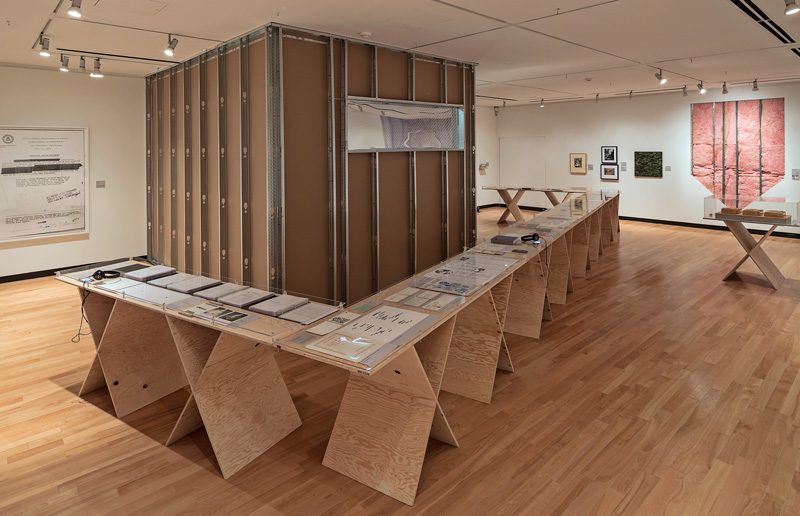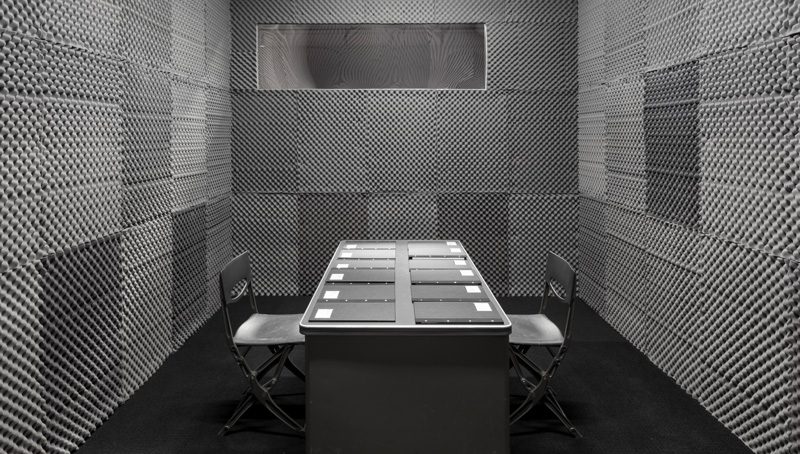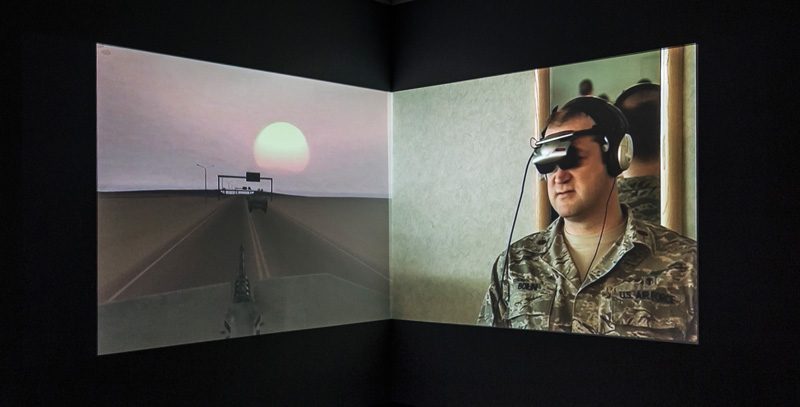Justina M. Barnicke Gallery, Toronto
24 January to 16 March 2014
By Jill Glessing
The rich-text title CounterIntelligence that introduces an exhibition, writings, workshop, and film screenings considers two cultural nodes and production modes – art and military activity. The project’s formal and thematic eclecticism befits the Berlin-based Canadian curator, Charles Stankievech, whose own work traverses the fields of sound and visual art, writing, and publishing.
Connections between the realms of art and war are well known: Leonardo’s designs for bombardment and defense technology; Marinetti’s Futurist enthusiasm for war as “the world’s only hygiene,” made concrete in his poem that sounded gunfire; and the CIA’s Cold War presence within the Museum of Modern Art and its ideological capture of avant-garde art.
Stankievech’s project springs from these instances into an intricate web of espionage, surveillance, military strategy, and multiple art forms. Invitations for sub and meta levels of interpretation are also suggested, through poststructuralist spatial theory and the politics of information gathering and archiving, curation, and the production of meaning in general.
To the curator’s credit, not only do more than a hundred documents and artworks fit comfortably into the modest JMB galleries but they do so with thematic elegance. In the first two rooms, four videos work together to clarify the contradiction between simulated and real war. In Harun Farocki’s two-channel video, Serious Games IV: A Sun with No Shadow (2010), American soldiers use video game simulation to first train for, then recover from, real war. In the adjoining room are two video games produced by the U.S. military (America’s Army, 2002–05) and Hezbollah (Special Force, 2001). Though the production values are different, the works share the representation of male bonding through guns and the goal of recruitment.
As the gunshot sound caroms around the room, viewers can access, in a fourth video, what is absent in the others – reality. A disturbing counterpoint to the polished game simulations is Collateral Murder (2010). This video, leaked courtesy of Wikileaks, shows a U.S. military helicopter attacking innocent Iraqis. After a Reuters journalist, whose camera has been mistaken for a weapon, is shot, his Iraqi guide arrives in a van to help him. As the attack continues, the guide is killed and his two daughters injured, an outcome casually dismissed by the soldiers: “Serves them right for bringing children into a war zone.”
The story of British double agent and art historian Sir Anthony Blunt carries thematic weight here for his complex entanglements as Cambridge don, spy for both MI5 and the Soviets, respected art historian, and advisor to the National Gallery of Canada in its acquisition of a painting that Blunt incorrectly attributed to the French artist Poussin. Blunt’s convoluted history is presented by Stankievech’s installation of a transparency of the painting projected onto a collaged radiographic facsimile that reveals the shadow marks of authenticity beneath the surface. Fabian Reimann’s double-exposed photograph of Blunt, One Second Distance (2008–10) provides another image of that layered life.
The earliest document here is a letter by Peter Paul Rubens (1630), who also dabbled doubly in art and intelligence. Rubens’s portrait painting provided perfect cover for his brokering of secret peace negotiations among Spanish, English, and Dutch royalty and states- men, a tripartite relation reflected in the letter’s marginalia.
The theme of camouflage is introduced through a large square of Canadian Disruptive Pattern textile (CADPAT, 1995) stretched on a frame like an abstract canvas. Its pixelated edges of green, brown, and black provide added protection and make it an international favourite. Across the room, and the world, Richard Mosse’s alarmingly pink Congo landscape, Colonel Soleil’s Boys (2010), photographed with the infrared film stock used by the military to detect camouflaged objects, clarifies military hierarchy. Unlike the colonel, whose newer infrared-resistant uniform blends with his surroundings, his soldiers stand out against the pink, vulnerable in their older gear.
Modernist British artists doubled as camoufleurs during the First World War. Their painting of the dazzle design onto ships prevented enemy submarines from focusing on and torpedo-bombing them. Edward Wadsworth’s woodcut print A Ship Being Painted with Dazzle Camouflage (1942) shows the crossover between his Vorticist aesthetic and military defence.
In contrast to the goal of evading enemy notice is the international Blue Shield symbol used to distinguish museums and deter attack. Abbas Akhavan’s Study for the Blue Shield (2011) is a large cutout in the gallery wall. The missing section was painted with blue triangles, suggestive of abstract art’s universal geometry, and stationed on the gallery roof.
The subject of military strategy is taken up in Eyal Weisman’s Forensic Architecture presentation (2004). The compilation, displayed on an iPad, includes PowerPoint slides and interviews with generals from the Israeli Defense Forces (IDF) who appropriated anti-capitalist spatial theory for their long-term urban warfare methodology. Borrowing the language of poststructuralist thinkers such as Guy Debord and Gilles Deleuze, the intellectual-generals confidently describe the manoeuvres effectively deployed during attacks on Palestinian refugee camps. To avoid ambush in roads and alleys, internal rhizomatic networks were made through Palestinian homes by exploding holes in walls. This violent reconfiguration of urban space to facilitate control shows that even theory meant to liberate can be applied, like art, to opposite goals.
An IDF training camp modelled after Arab villages is named “Chicago” after that city’s bullet-ridden fame. Adam Bloomberg and Oliver Chanarin photographed the site, and their large photo mural of a concrete wall with pre-formed hole covers the gallery wall (Chicago #5, Tze’Elim Military Base, Negev Desert, 2005). In tight and traumatic conversation, Gordon Matta-Clark’s photograph Splitting figures a domestic home anarchitecturally severed through its middle (1974/2001).
Wooden display cabinets sweeping through the gallery hold bookworks and other paper documents. Joshua Simon and Stankievech’s Tahrir Square Lasers (2013), an iPhone-displayed video, is also installed here. The green laser light activity popular during the Tahrir Square protests shows the coupling of battle strategy and visual delight. The protester-wielded laser lights provided signalled solidarity through pop art entertainment, but also identified snipers and confused helicopters overhead.
One of the most successful pieces that sutures the division between dry documents and visual aesthetics is Stankievech’s model interrogation room complete with a mirrored window, a table holding ten binders, and two chairs, allowing it to double as a comfortable reading room. In this small library, readers can find the plans used to construct the room itself – a CIA Human Resource Exploitation Manual and El Lissitzky’s Proun room. Also included is an amusing 2011 letter from Colonel Gaddafi’s staff urging a New York Times fashion editor to curate a 2013 Metropolitan Museum of New York exhibition of the trend-setting Libyan leader’s 3,500-piece wardrobe, then endangered by the NATO bombing of his headquarters. In a corner stands a contribution by Anna-Sophie Springer, a Dracaena plant (Cleve Backster Interrogates Janet Craig, 2014), the genus on which CIA interrogator and polygraph inventor Cleve Backster experimented. Wiring the poor plant with electrodes, he found that even thinking about putting a match to its leaves created a frenetic response in the sensor.
Backster’s style of intelligence seeking may be frightening, but other perils attend this project. The collision that Stankievech has orchestrated between the real military world and the symbolic realm of art opens up an interpretive space that can travel in multiple directions. Audiences, especially the more paranoid among us, risk spiralling into a black hole of meaning that doubles the shadowy space of the double agent. It is hard not to perform the very subject of this exhibition.
Jill Glessing is a writer, artist, and teacher of art and cultural history at York University and Ryerson University



